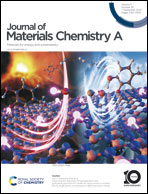Ultra-high initial coulombic efficiency of the TiO2 anode induced by the synergistic role of the electrolyte and binder for sodium-ion batteries†
Abstract
The TiO2 anode for sodium-ion batteries (SIBs) is currently drawing increased attention owing to its stable cycling performance. However, the storage performance is still extremely inadequate, especially for its low initial coulombic efficiency (ICE). In order to further improve the ICE, a good match of the electrolyte and binder is crucial, due to the fact that a solid electrolyte interface (SEI) is irreversibly formed on the surface, which will be very important for its reversible capacity. As an attempt, TiO2 nanocrystallites are prepared by an electrochemical method. When applied as the anode for SIBs, the TiO2 electrode with the sodium carboxymethylcellulose binder and ether-based electrolyte presents an impressive capacity of 166.23 mA h g−1 at 2C after 4800 cycles, much higher than that with the polyvinylidene fluoride binder and carbonate-based electrolyte. A series of characterization studies reveal that the charge transfer at the interface between the electrolyte and electrode and the SEI film are the key factors determining the electrochemical properties. Importantly, the dual optimization of the binder and electrolyte is revealed to be an effective means to enhance the ICE of TiO2 up to 81.6%, thus greatly contributing to better guidance on the design of TiO2 anodes with ultra-high ICE for SIBs.

- This article is part of the themed collection: #MyFirstJMCA


 Please wait while we load your content...
Please wait while we load your content...